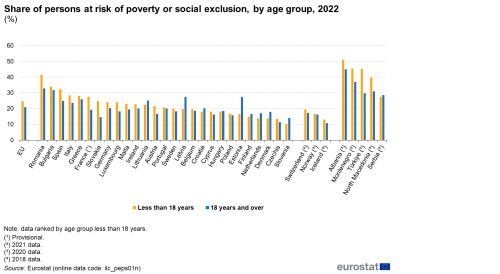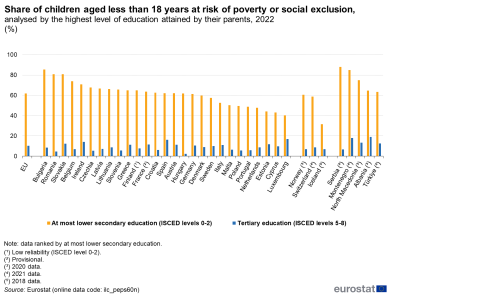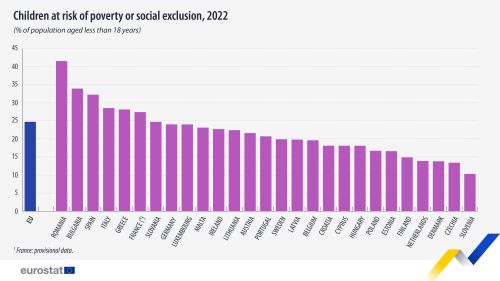Children at risk of poverty or social exclusion
Data extracted in September 2023.
Planned article update: September 2024.
Highlights
In 2022, 24.7% of children aged less than 18 in the EU were at risk of poverty or social exclusion compared with 24.4% reported in 2021.
In 2022, 24.7% of children aged less than 18 in the EU were at risk of poverty or social exclusion compared with 20.9% of adults (aged 18 and more).
In 2022, in the EU, 10.2% of children aged less than 18 whose parents’ level of education was high were at risk of poverty or social exclusion compared with 61.9% of children whose parents level of education was low.
This article presents statistical data on the situation of children (aged less than 18 years) in the European Union (EU) who were at risk of poverty or social exclusion (AROPE) in 2022. The analysis compares children with adults (aged 18 years and over) and displays the impact of the parents' educational level. All figures are based on EU statistics on income and living conditions (EU-SILC) available from Eurostat’s online database. EU-SILC data are available for all EU Member States, as well as for most of the EFTA and candidate countries.
Full article
Key findings
In 2022, 24.7 % of children (aged less than 18 years) in the EU were at risk of poverty or social exclusion, compared with 20.9 % of adults (aged 18 years and over). Figures show that the higher the educational attainment level of parents, the lower was the share of the children at risk of poverty or social exclusion: for children whose parents’ level of education was low, this share was 61.9 %, compared with 10.2 % for children whose parents’ level of education was high.
Children at risk of poverty or social exclusion
Children aged less than 18 years growing up in poverty or social exclusion encounter difficulties to do well in school, enjoy good health and realize their full potential later in life. They also face a higher risk of becoming unemployed, poor and socially excluded as adults.
The share of persons who are at risk of poverty or social exclusion encompasses persons who are in at least one of these three situations:
- persons who are at risk of poverty: those with an equivalised disposable income that is below the at-risk-of-poverty threshold;
- persons who suffer from severe material and social deprivation: those who cannot afford at least seven out of thirteen deprivation items (six related to the individual and seven related to the household) that are considered by most people to be desirable or even necessary to lead an adequate quality of life;
- persons (aged less than 65 years) living in a household with very low work intensity: those living in households where adults worked equal to or less than 20 % of their total combined work-time potential during the previous twelve months.
In 2022, in the EU, the share of children at risk of poverty or social exclusion was 24.7 %. At national level, the highest values were reported in Romania (41.5 %), Bulgaria (33.9 %) and Spain (32.2 %). On the other hand, the lowest shares were recorded in Slovenia (10.3 %), Czechia (13.4 %) and Denmark (13.8 %).
The share of children at risk of poverty and social exclusion slightly increased from 2021 to 2022
In the EU, between 2021 and 2022, the share of children at risk of poverty or social exclusion increased from 24.4 % to 24.7 % (Figure 1). Eight Member States presented the same pattern, with Slovakia and France recording the highest increases: 5.0 and 4.7 percentage point (pp), respectively. On the other side, the largest decreases were observed in Luxembourg (- 5.4 pp), Hungary (- 5.2 pp) and Greece (-3.9 pp).

(%)
Source: Eurostat (ilc_peps01n)
In 2022, the share of children at risk of poverty of social exclusion was higher for children than for adults
As shown in Figure 2, in 2022 children (aged less than 18 years) in the EU were at a higher risk of poverty or social exclusion compared with persons aged 18 and over (24.7 %, a difference of 3.8 pp). Eighteen EU Member States presented a similar situation, with the highest differences recorded in Slovakia (10.1 pp), Romania (8.8 pp), France (8.1 pp) and Spain (7.5 pp). Among the countries where more adults than children were at risk of poverty or social exclusion, the highest differences were observed in Estonia, Latvia and Denmark, where the shares of adults at risk of poverty and social exclusion were higher than the ones for children by 10.7, 7.7 and 4.1 pp, respectively.

(%)
Source: Eurostat (ilc_peps01n)
In 2022, children whose parents attained a higher education level were less likely to be at risk of poverty or social exclusion
In 2022, 61.9 % of children in the EU living in the same household as their parents whose highest level of education attained was at most lower secondary (ISCED "levels 0-2"), were at risk of poverty or social exclusion. On the other hand, the respective share for children living in the same household as their parents whose highest level of education attained belongs to tertiary education (ISCED "levels 5-8"), was 10.2 % — see Figure 4. The risk of poverty or social exclusion gap for children based on the parents’ level of education — difference of children’s risk of poverty or social exclusion between the highest and lowest levels of parents’ education — was therefore 51.7 pp.
At national level, the gap ranged from 23.6 pp in Luxembourg, 32.1 pp in Estonia and 33.2 pp in Cyprus to 68.4 pp in Slovakia, 76.2 pp in Romania and 77.1 pp in Bulgaria. In 17 out of the 27 Member States the gap was above 50.0 percentage points.

(%)
Source: Eurostat (ilc_peps60n)
Source data for tables and graphs
Data sources
The data used in this article are derived from EU-SILC. EU-SILC data are compiled annually and are the main source of statistics that measure income and living conditions in Europe; it is also the main source of information used to link different aspects relating to the quality of life of households and individuals.
The reference population for the information presented in this article is all private households and their current members residing in the territory of an EU Member State (or non-member country) at the time of data collection; persons living in collective households and in institutions are excluded from the target population. The data for the EU are population-weighted averages of national data.
Context
At-risk-of-poverty or social exclusion rate (AROPE) is the headline indicator to monitor the European Pillar of Social Rights Action Plan (EU 2030 targets) poverty target. It reflects the share of the population which is at risk of poverty, and/or severely materially and socially deprived and/or lives in a household with very low work intensity.
Educational attainment level is classified according to ISCED — the international standard classification of education. The (latest) 2011 version has the following levels:
- ISCED level 0 — early childhood education;
- ISCED level 1 — primary education;
- ISCED level 2 — lower secondary education;
- ISCED level 3 — (upper) secondary education;
- ISCED level 4 — post-secondary non-tertiary education;
- ISCED level 5 — short-cycle tertiary education;
- ISCED level 6 — bachelor’s or equivalent level;
- ISCED level 7 — master’s or equivalent level;
- ISCED level 8 — doctoral or equivalent level.
Direct access to
- Income and living conditions (ESMS metadata file — ilc_esms)
- Income and living conditions — information on data
- Income and living conditions — methodology
- Measuring material deprivation in the EU — Indicators for the whole population and child-specific indicators Methodologies and working papers
- Detailed list of legislative information on EU-SILC provisions for survey design, survey characteristics, data transmission and ad-hoc modules
- Regulation (EC) No 2019/1700 — — the central piece of legislation for social surveys including EU-SILC
- Regulation (EC) No 2019/2242 — — additional central piece of legislation for EU-SILC
- Summaries of EU Legislation: EU statistics on income and living conditions
